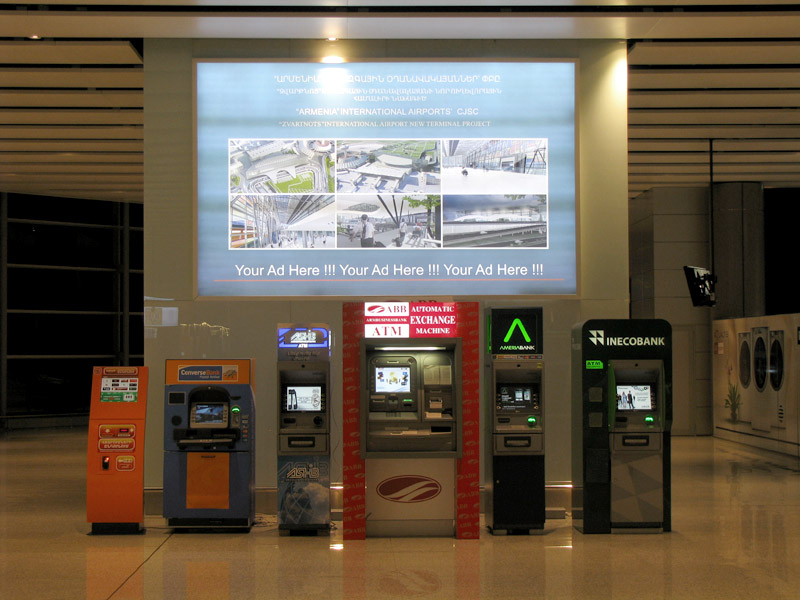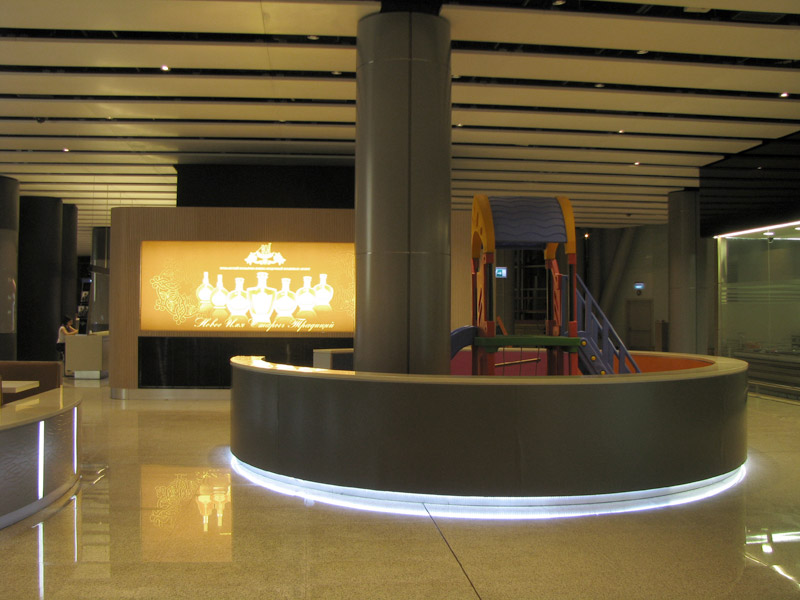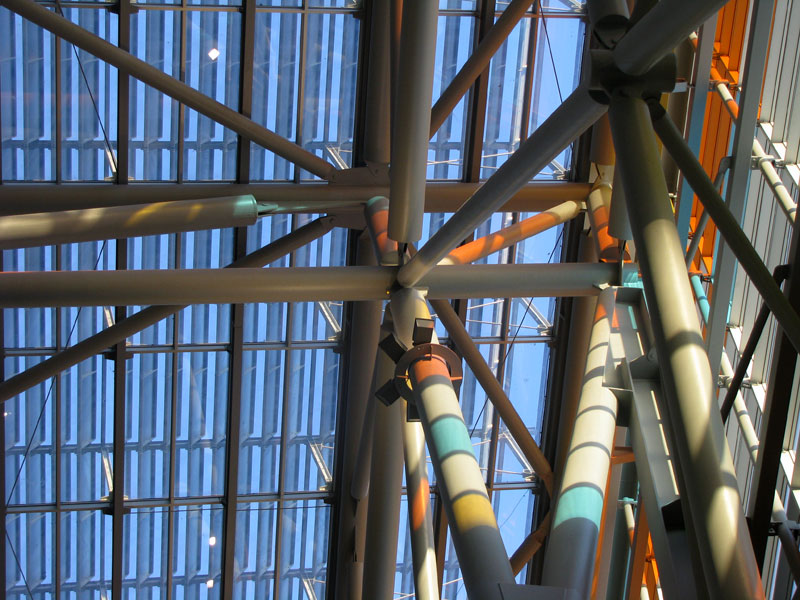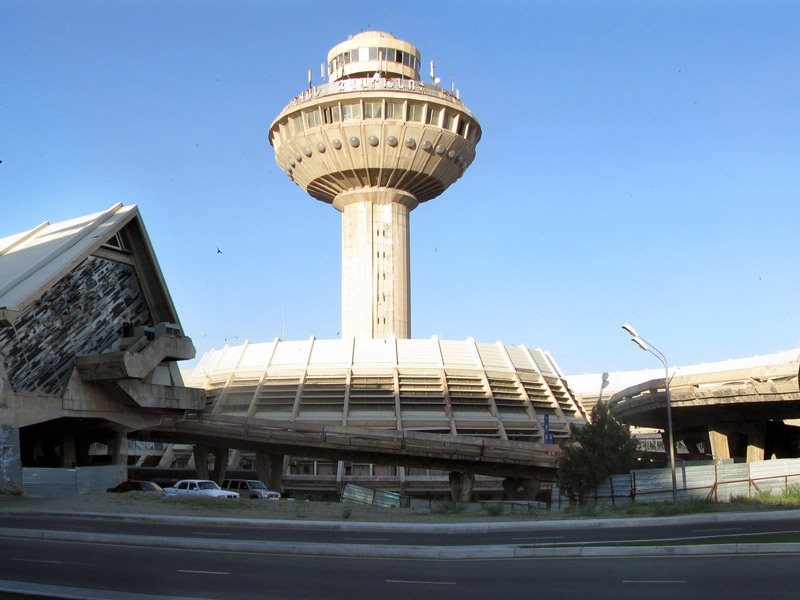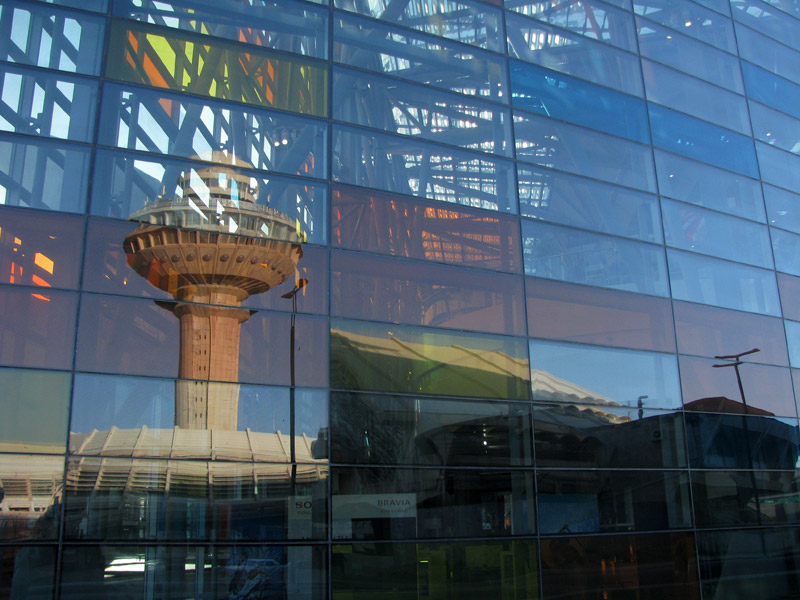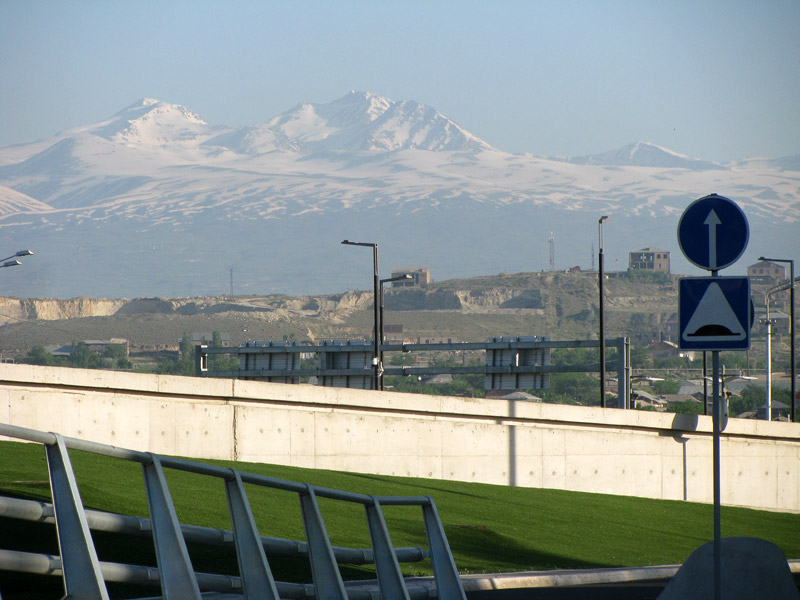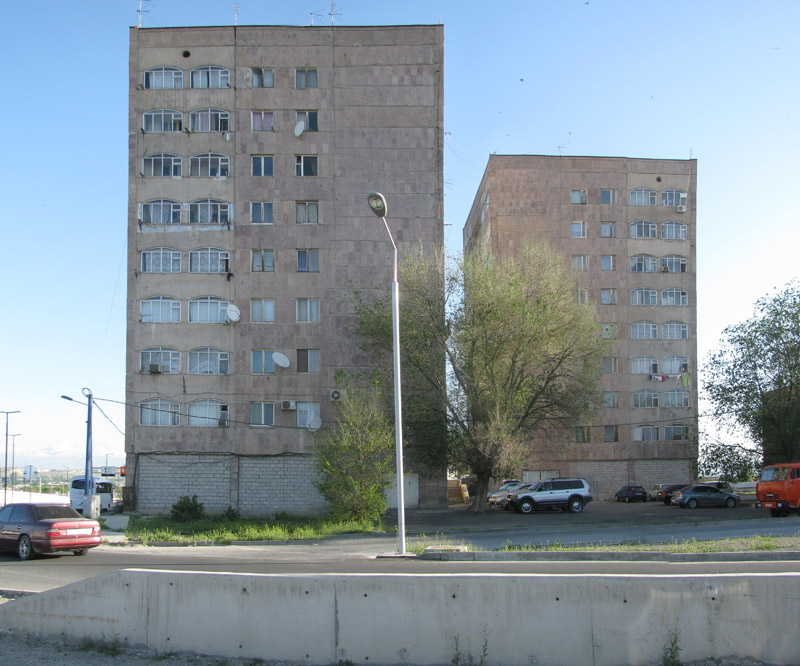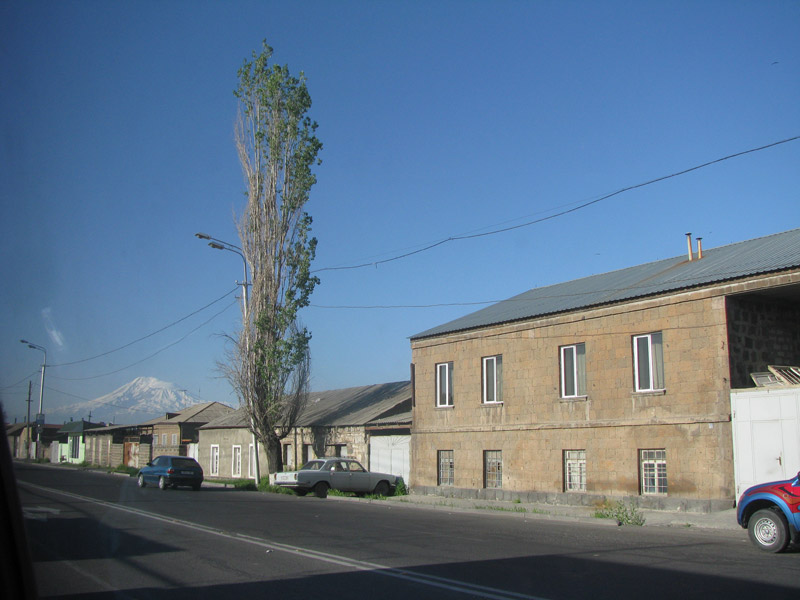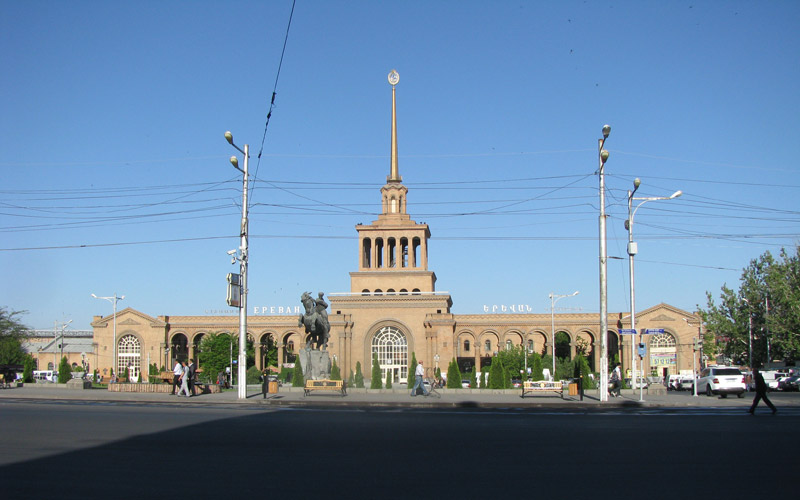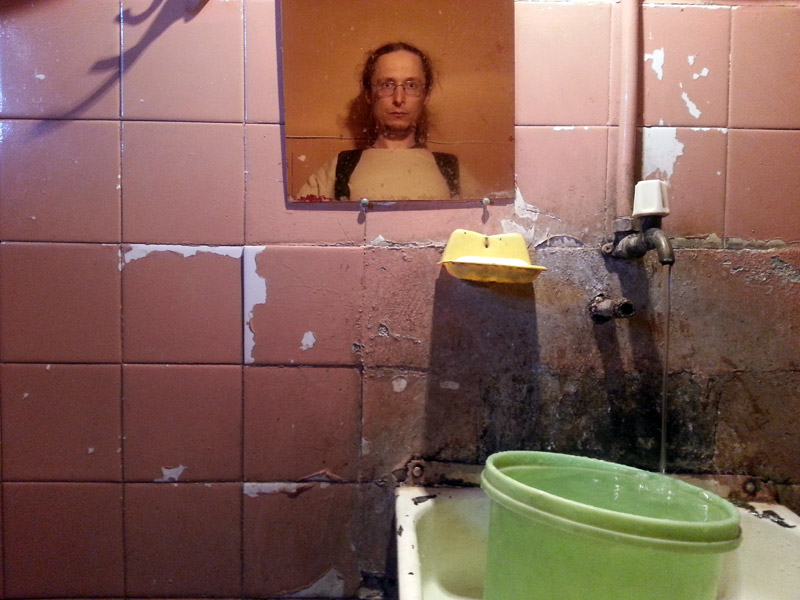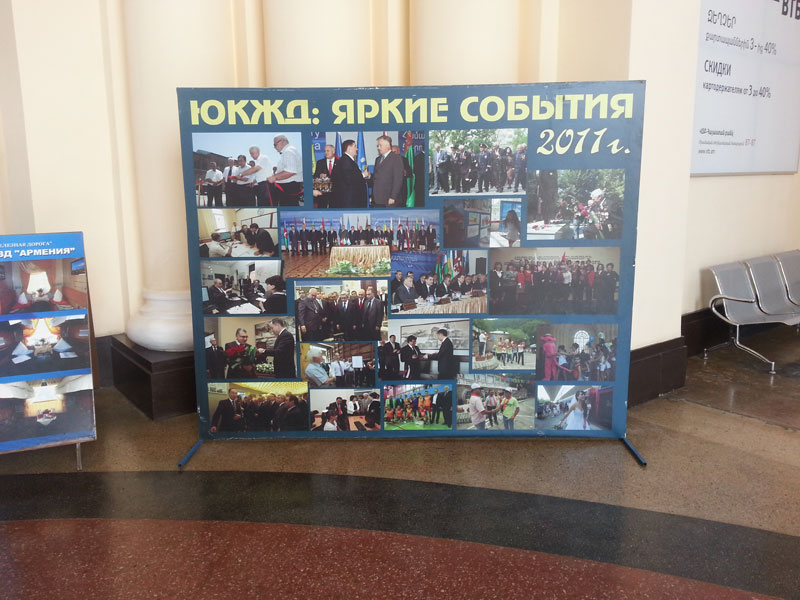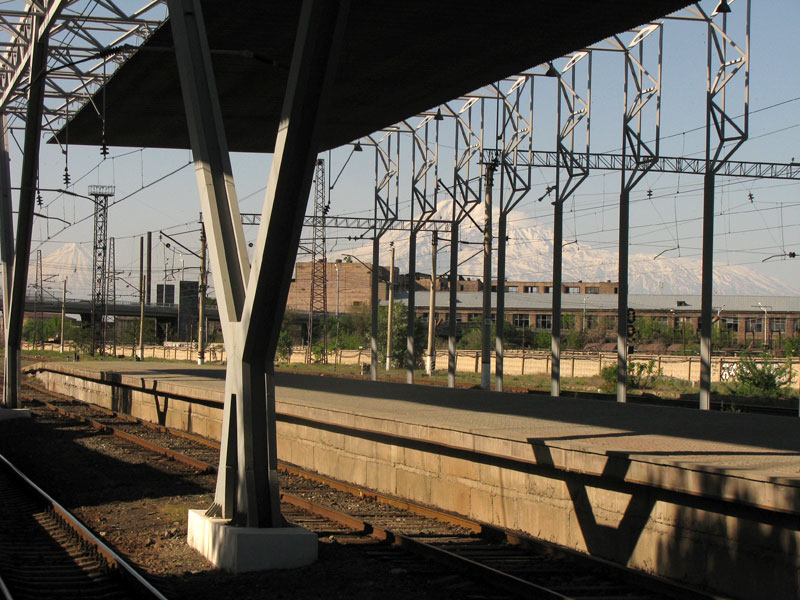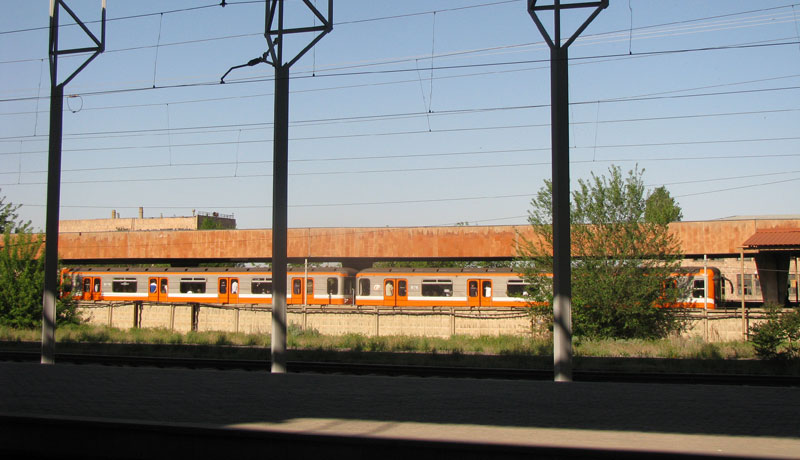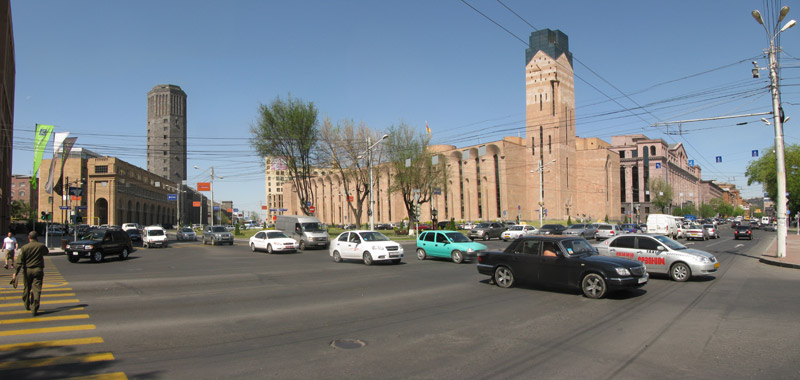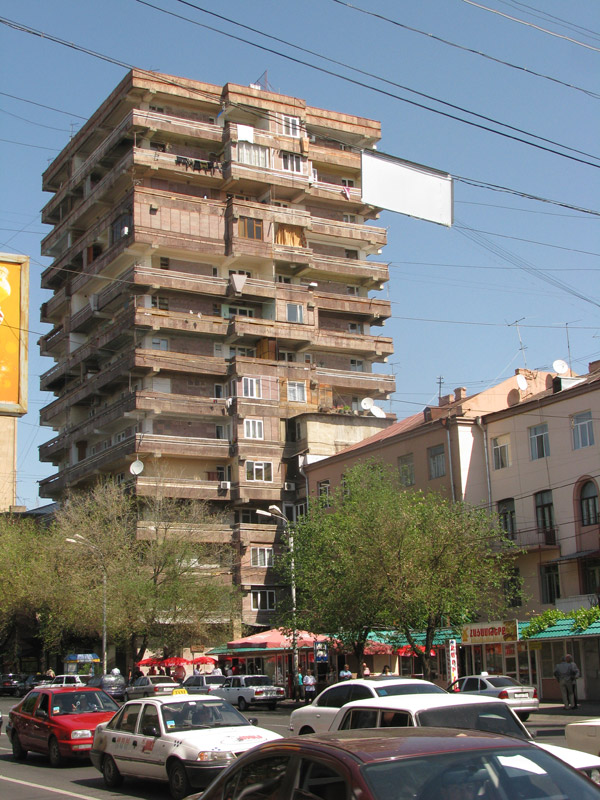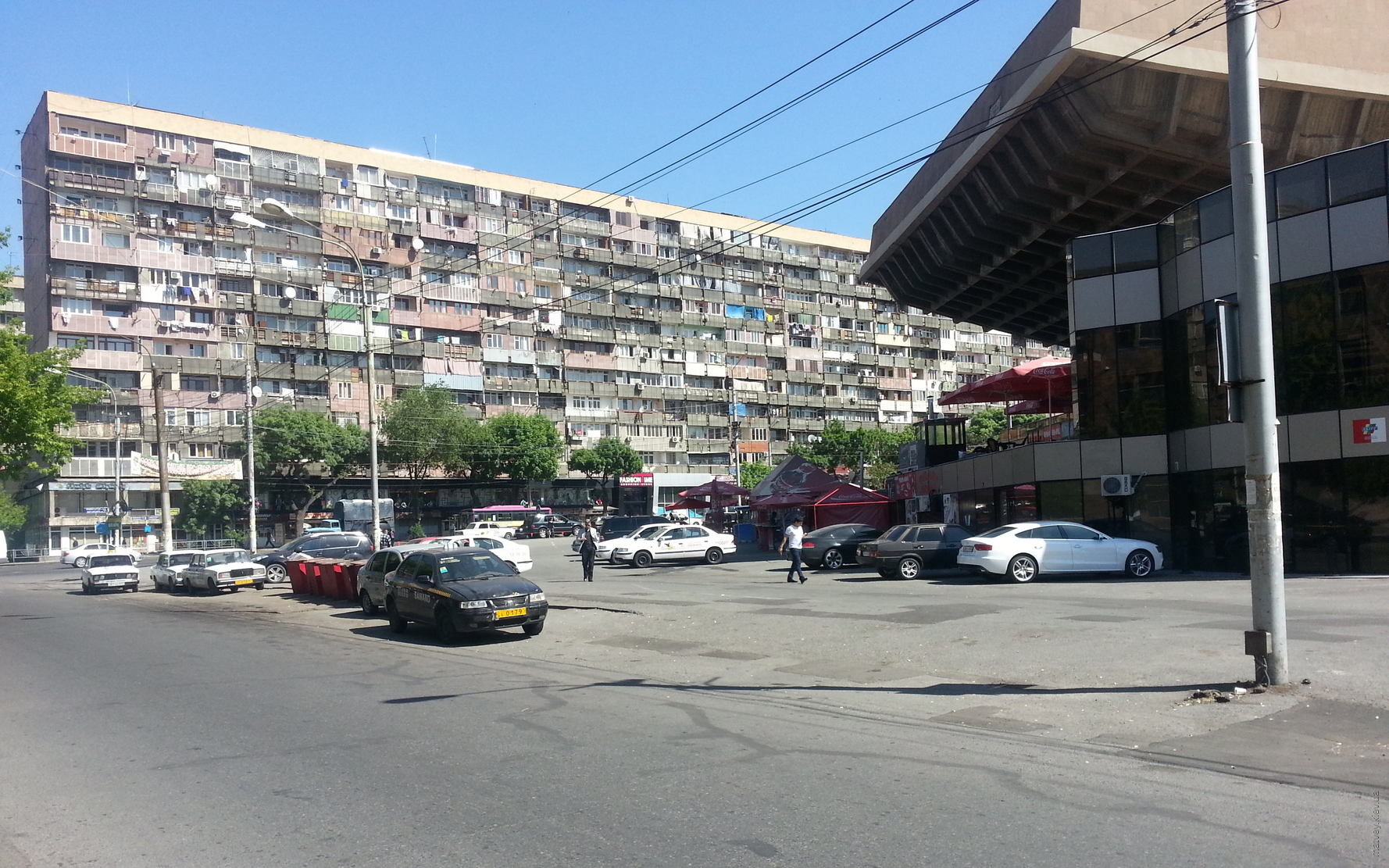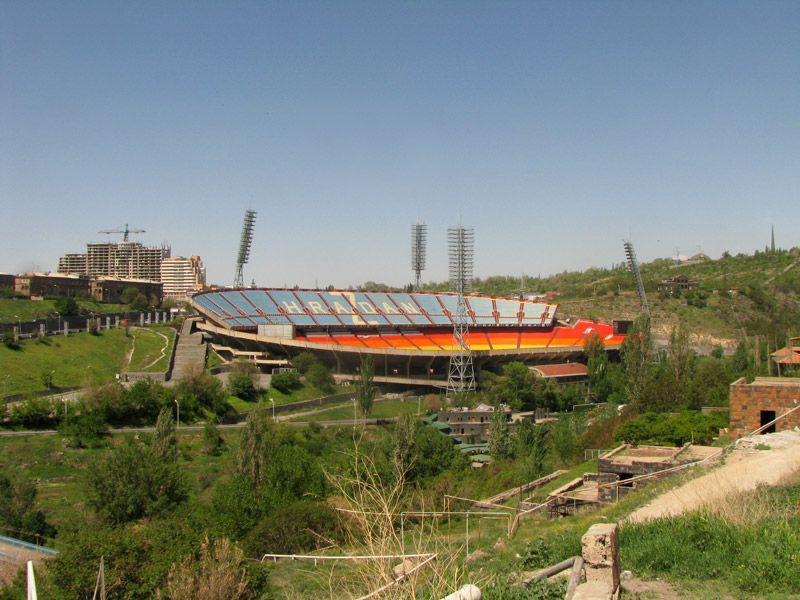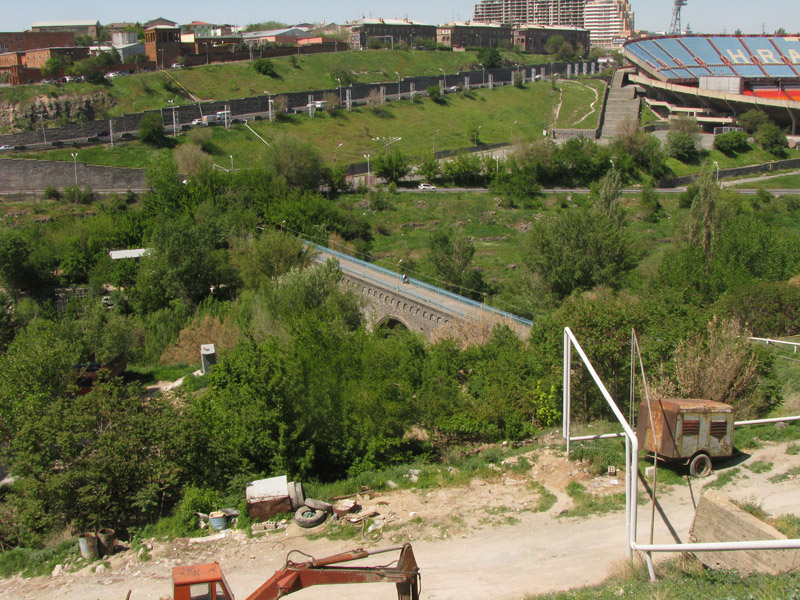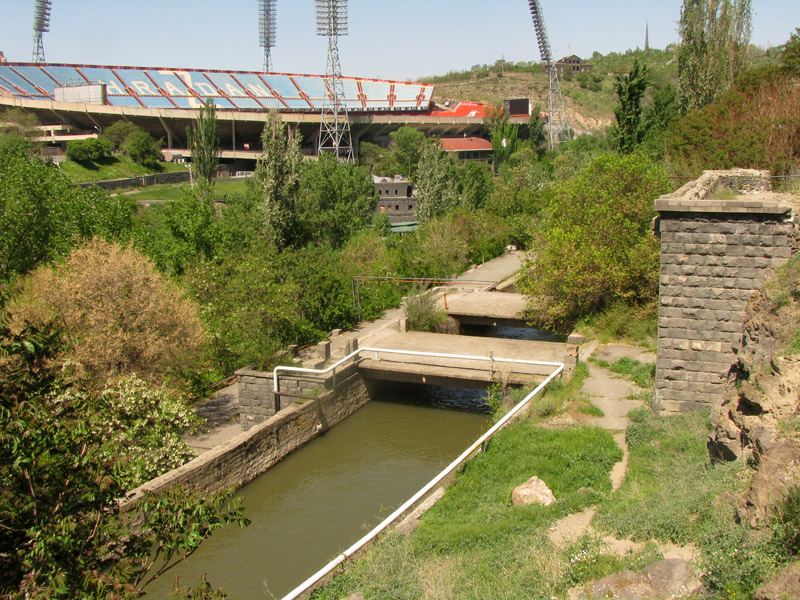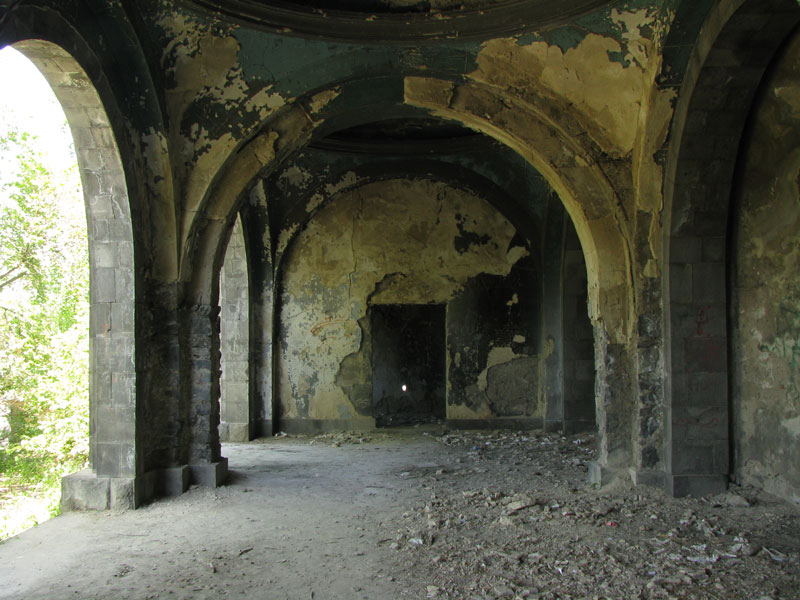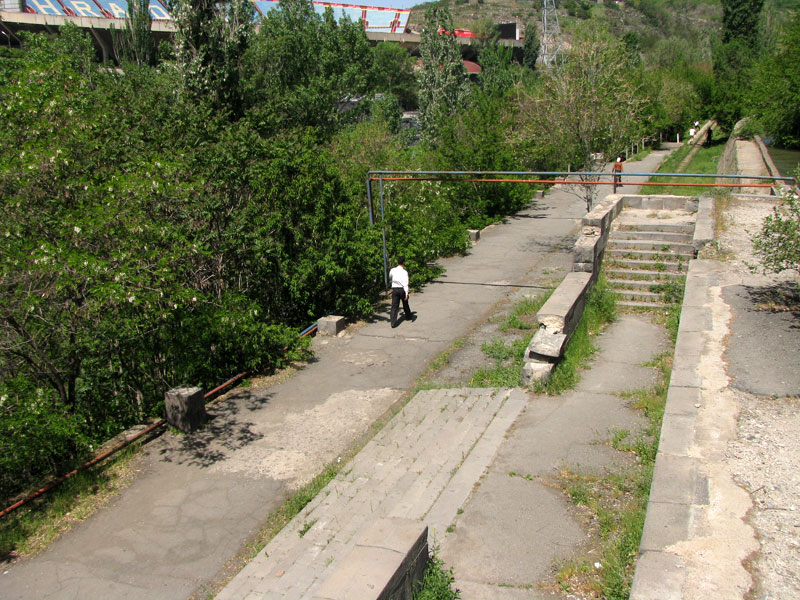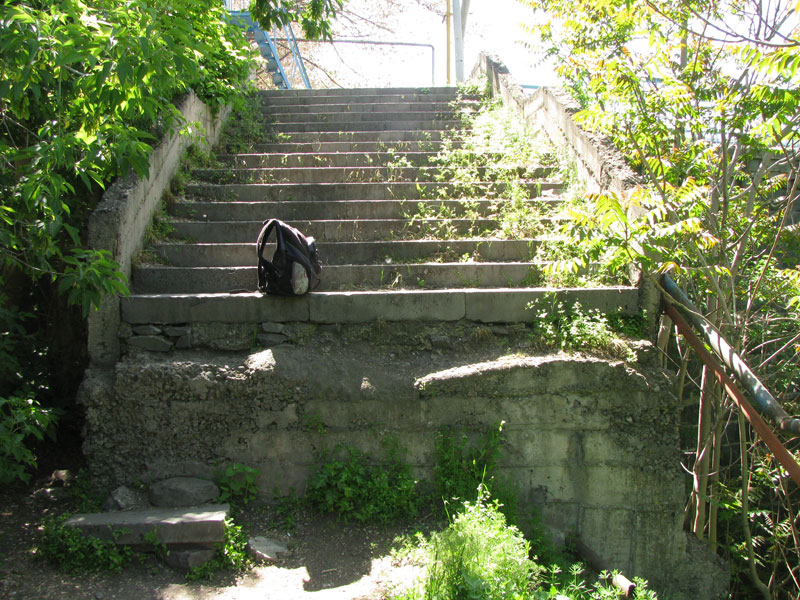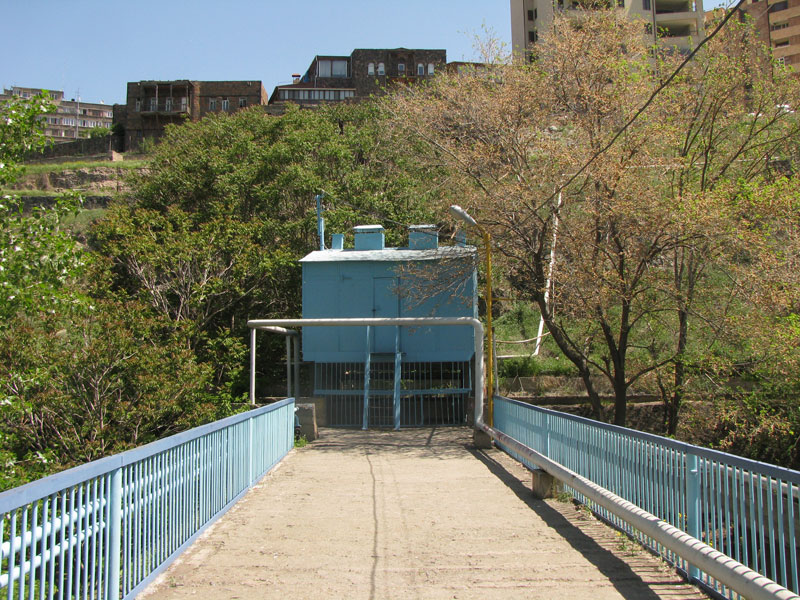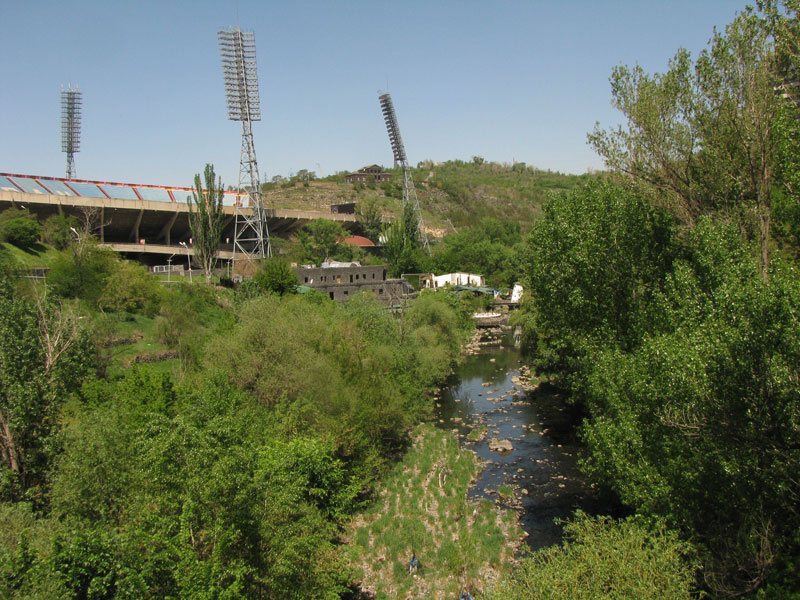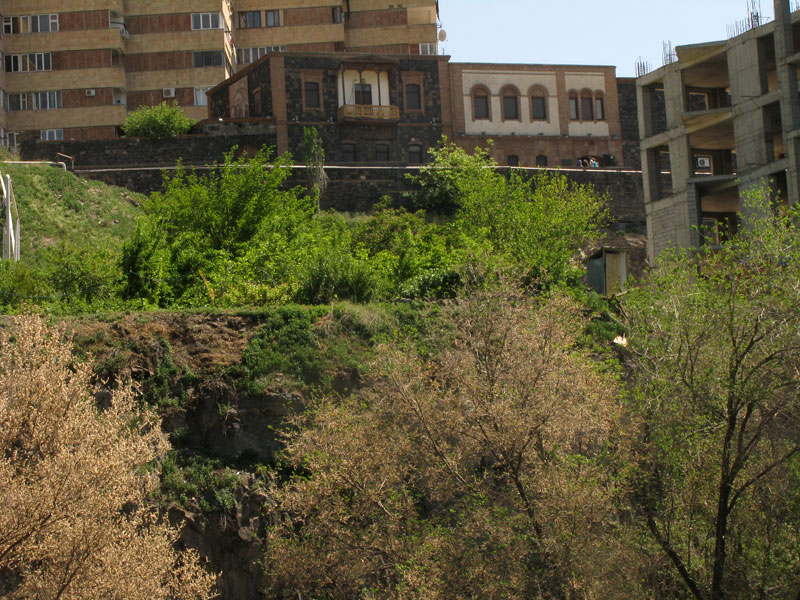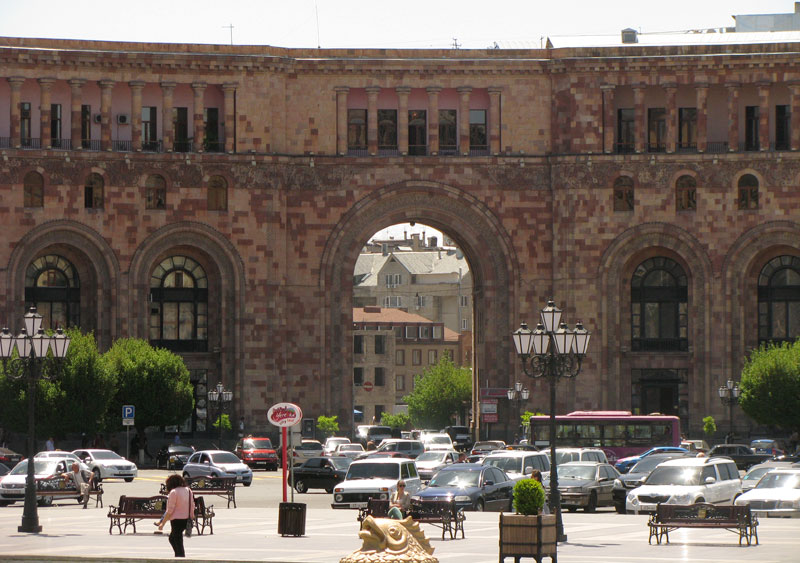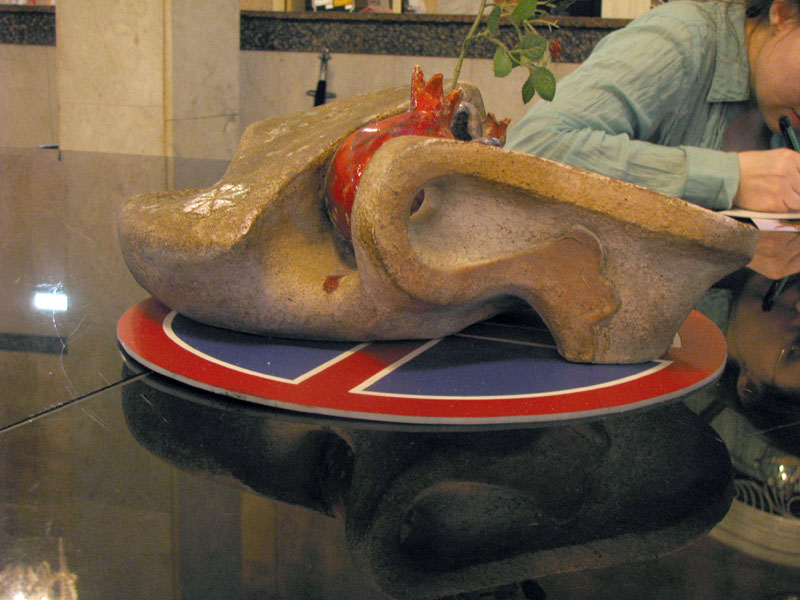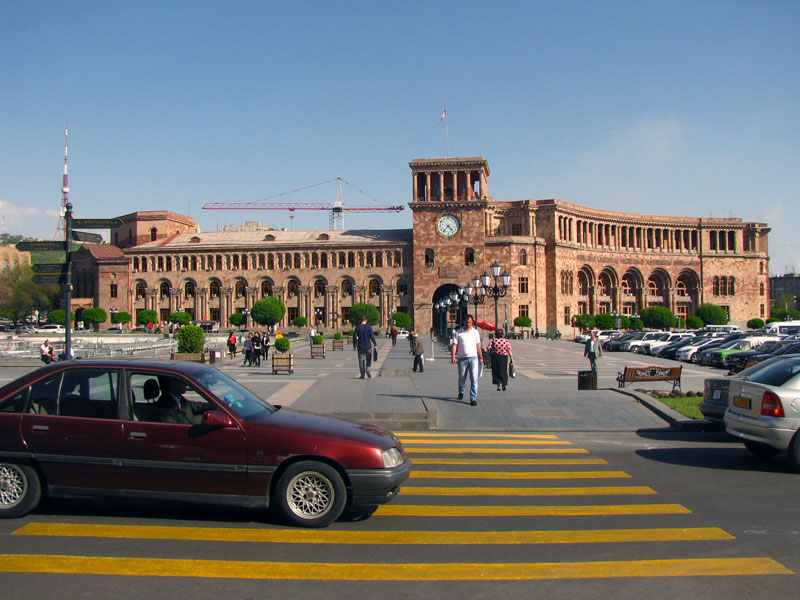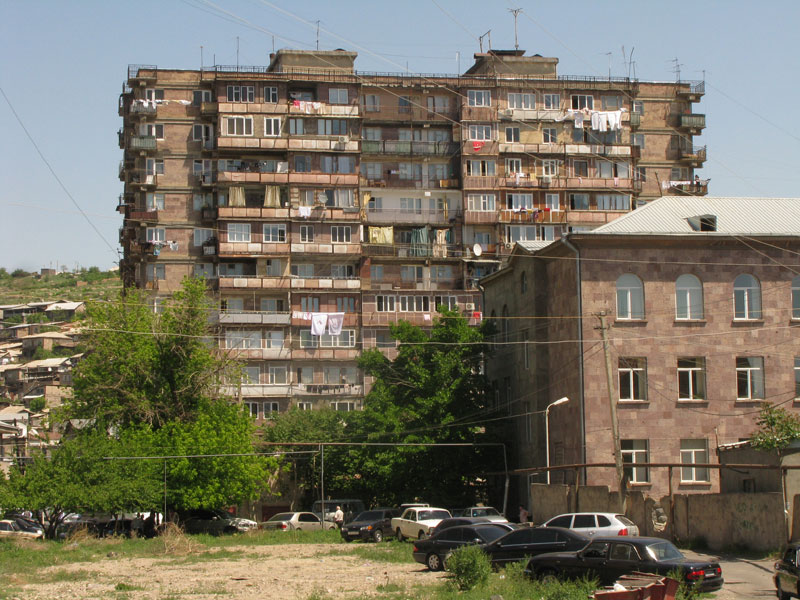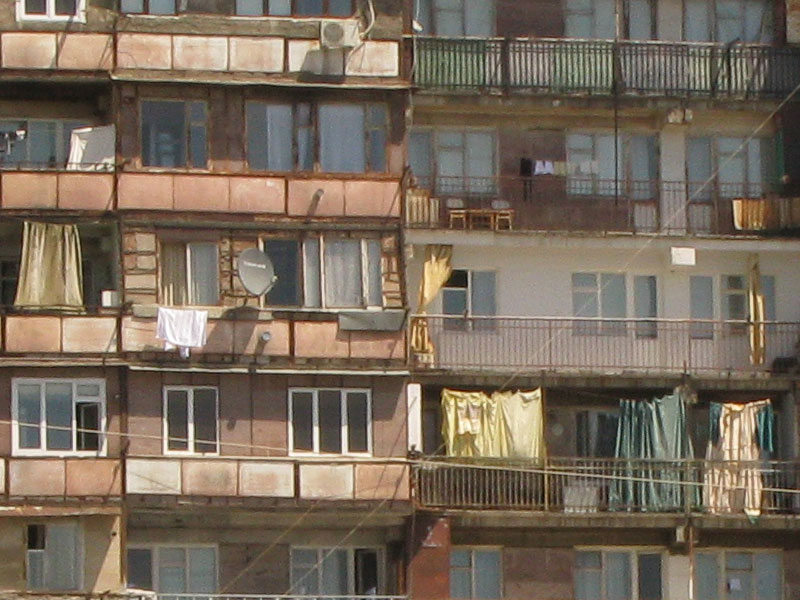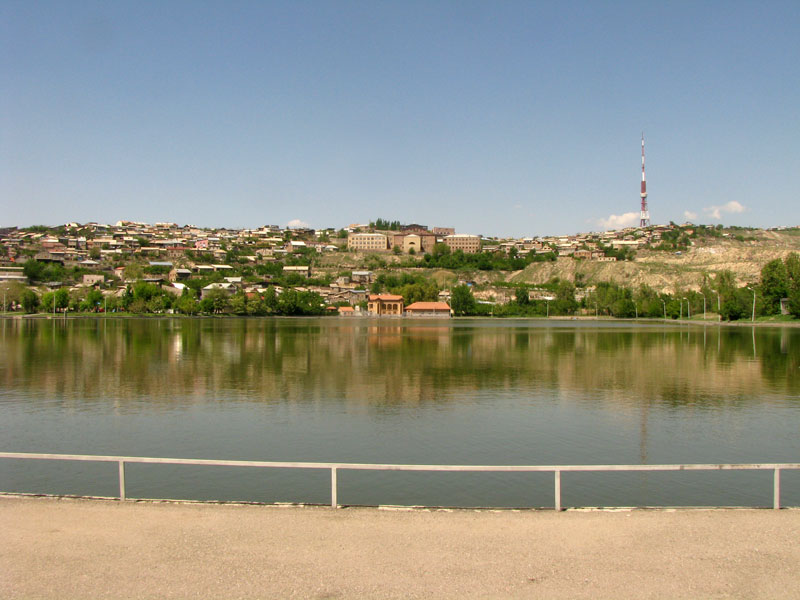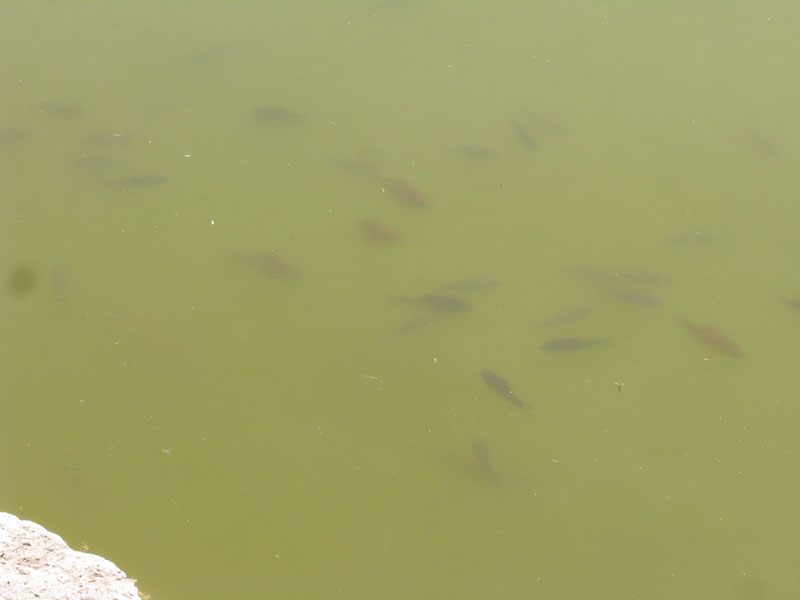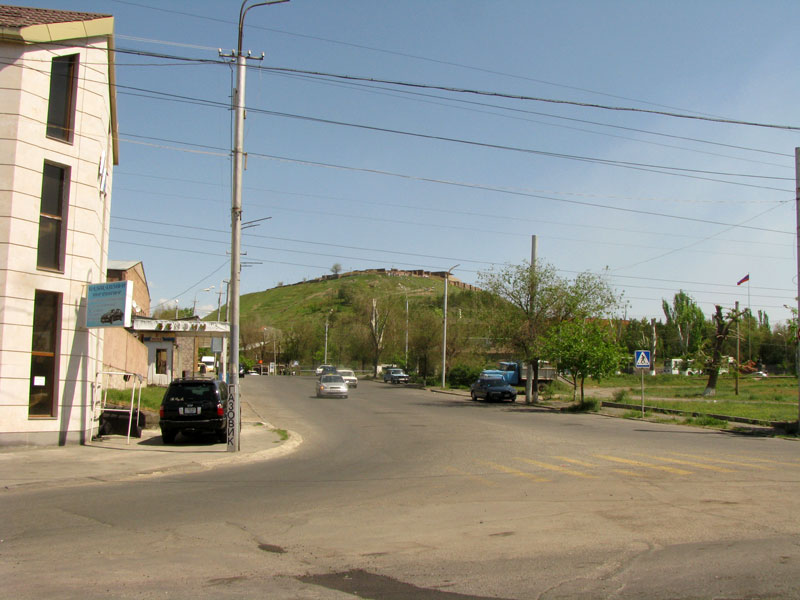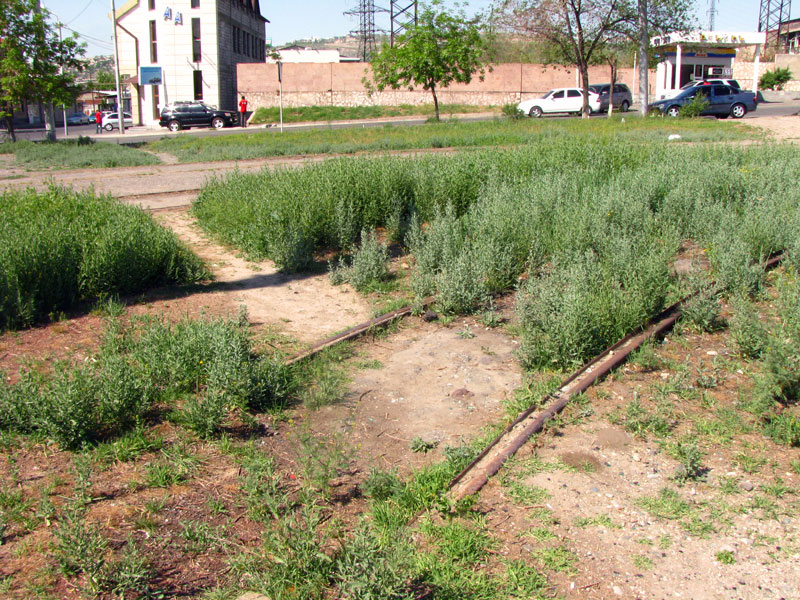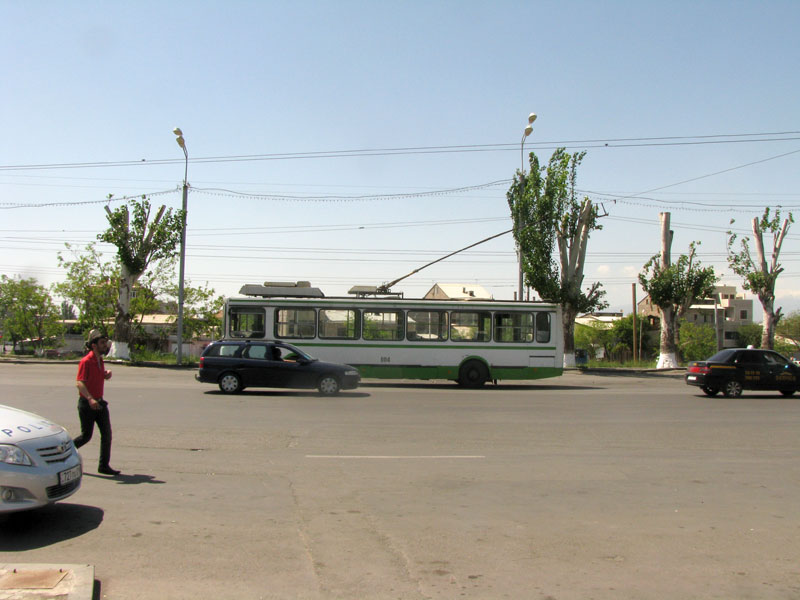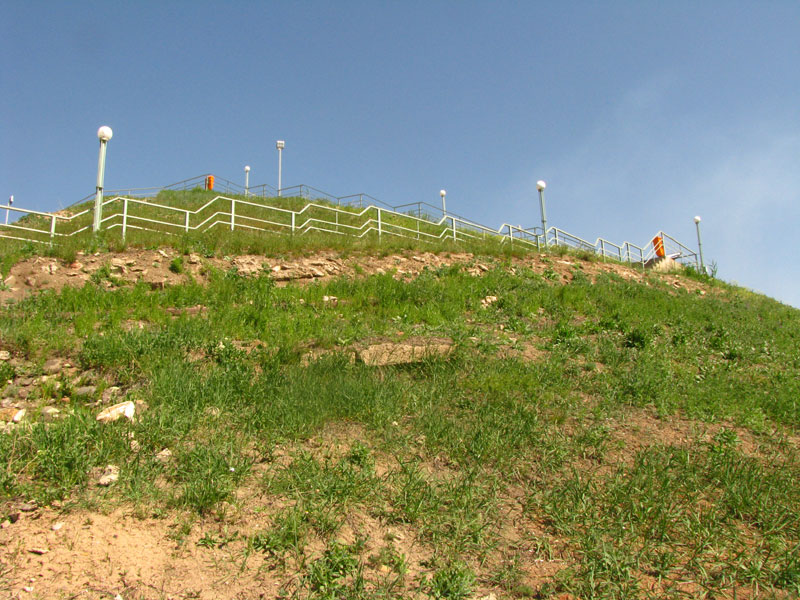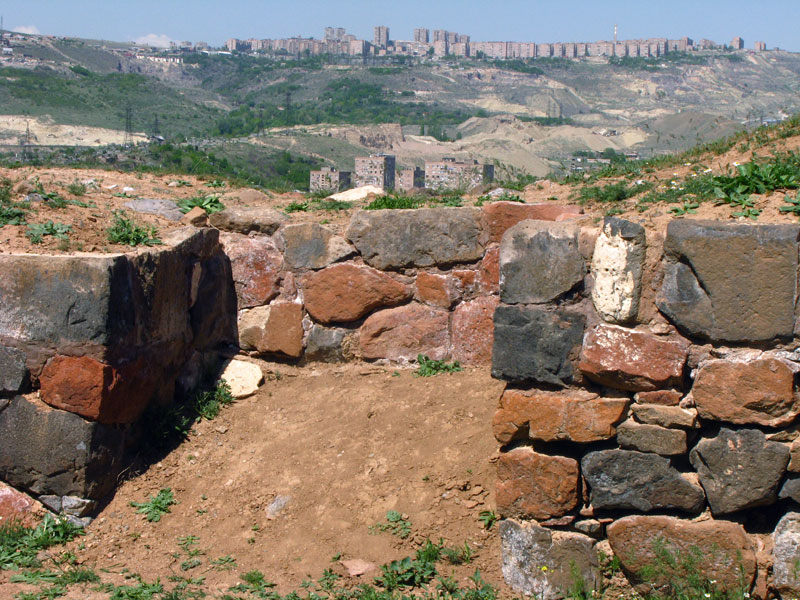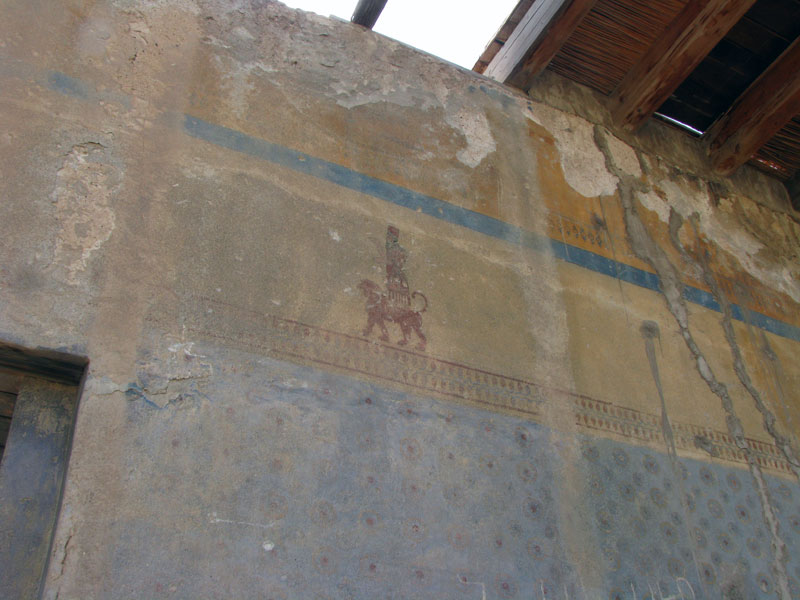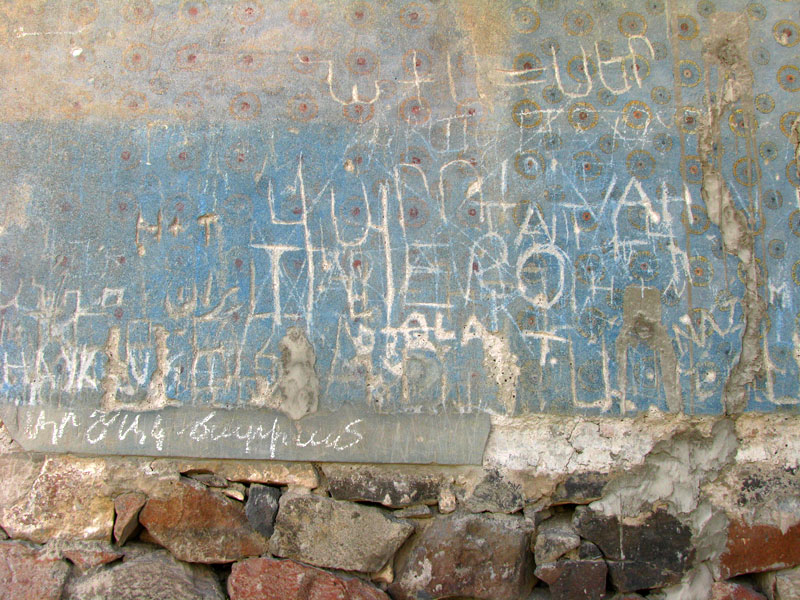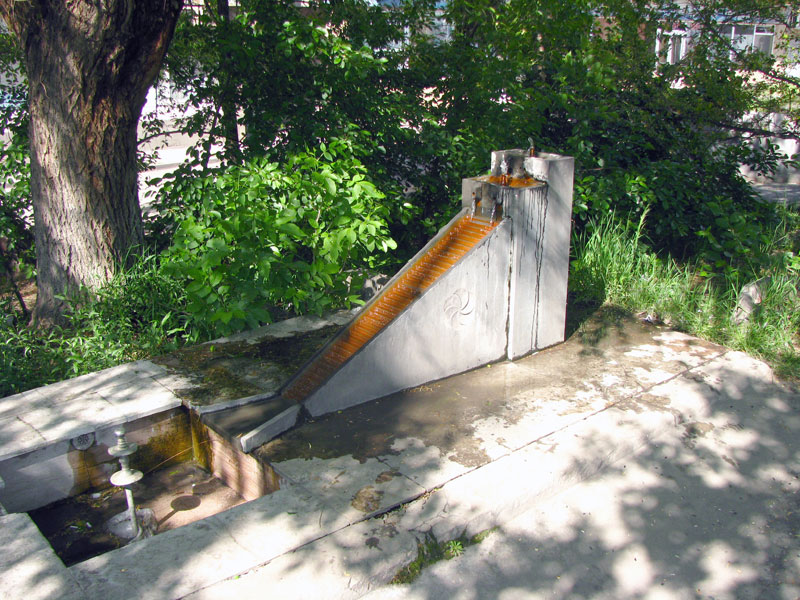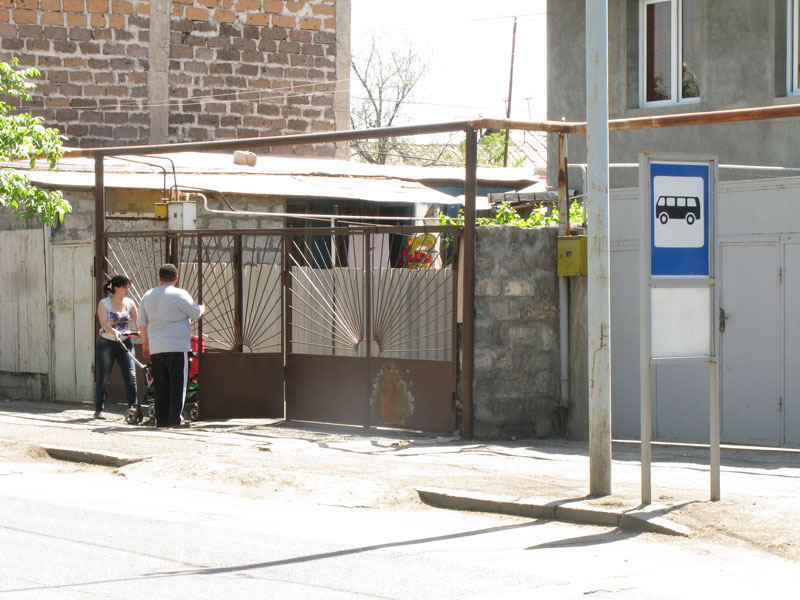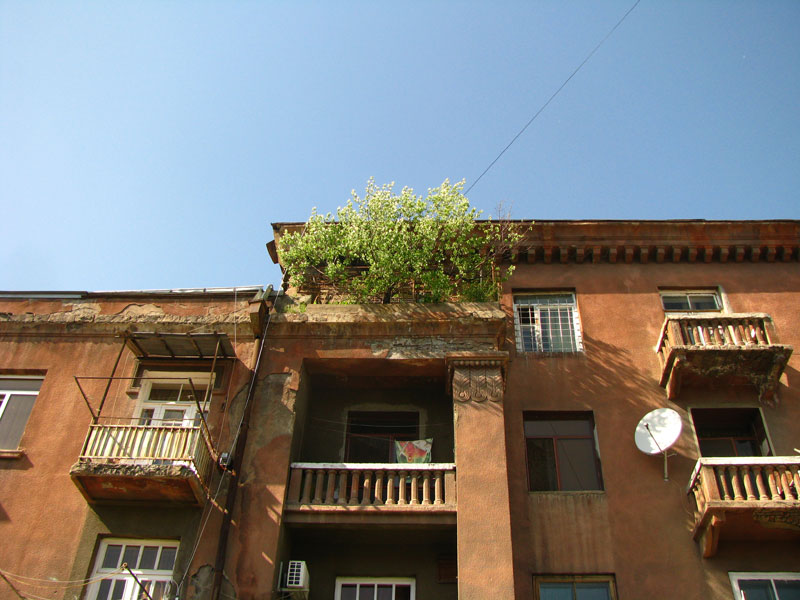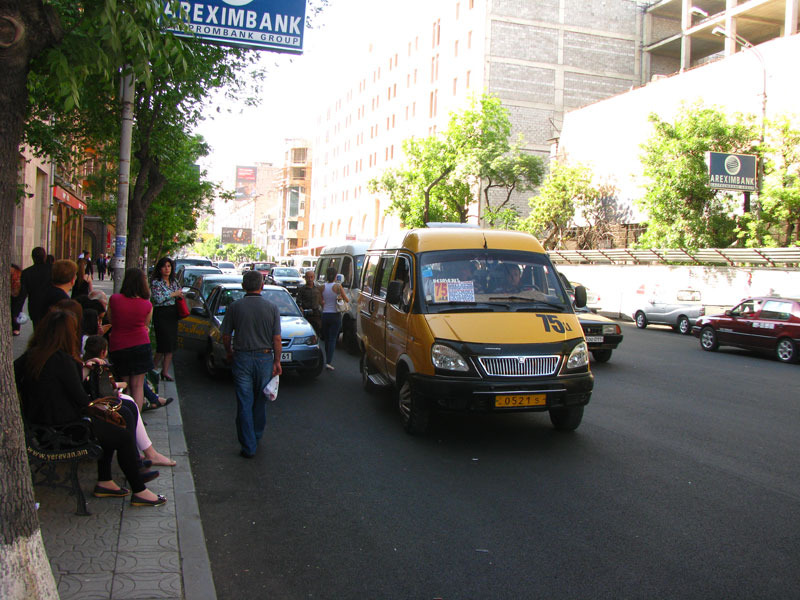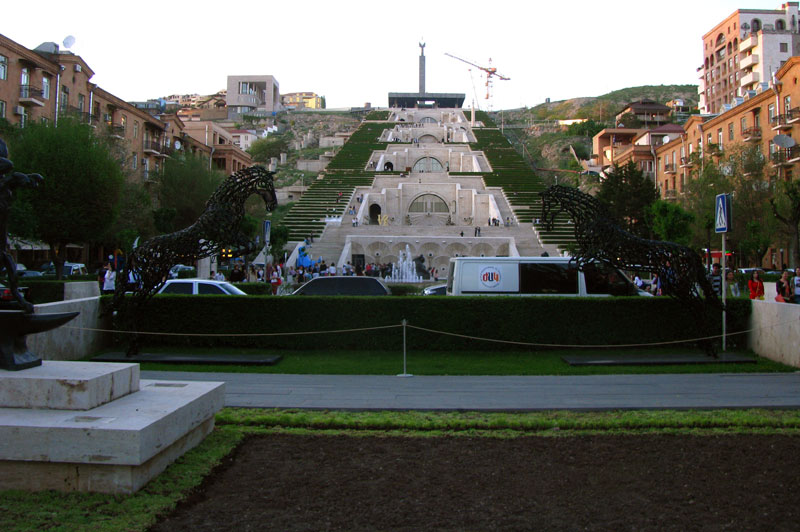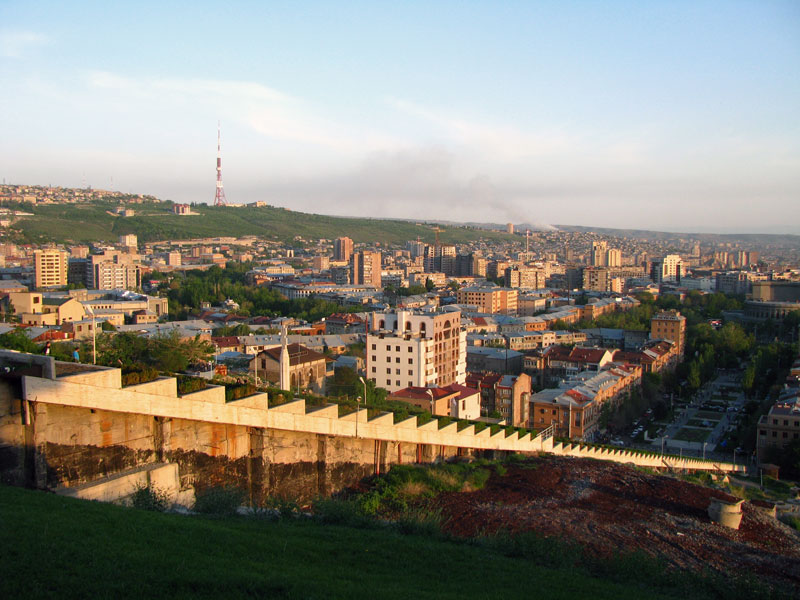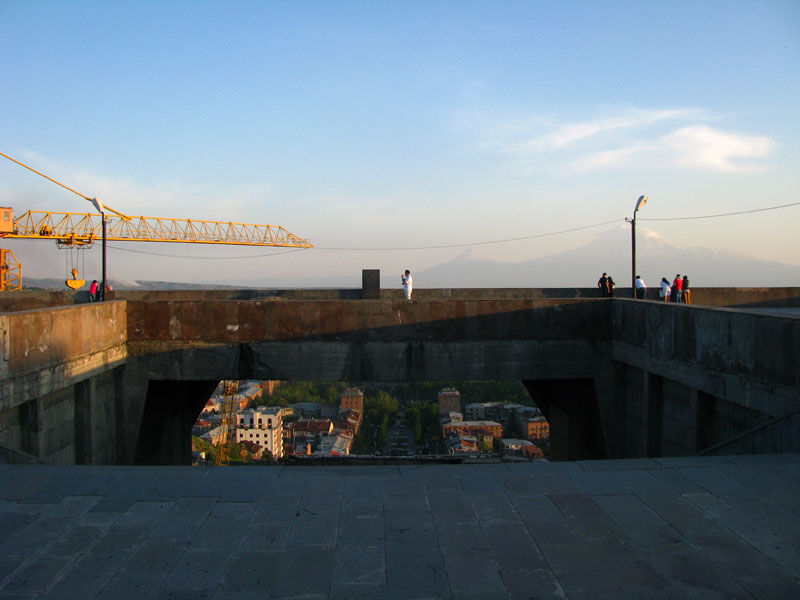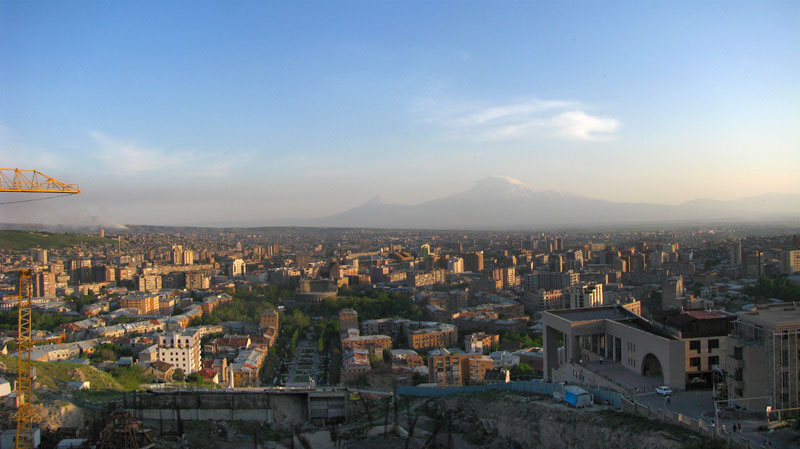This was my one day in Armenia. I saw the Hrazdan river, some central streets, walked to Erebuni and back.
I was in a company of two. We arrived in the middle of the night, and decided to torture ourselves by waiting in the Zvartnots airport until we can rıde away cheaply using a marshrutka №18. There weren't many flights, so the arrivals hall was mostly empty. I think I made several thousands steps walking back and forth in the terminal.
A nice row of ATMs and a tiny playground close to an alcohol ad.
The building was a new one. Some windows were colored, and the rising Sun projected these colorful rectangles on the pillars inside.
It was pitch black outside at night. The older, crazier building of the airport was completely invisible from a few dozen metres. I was surprised to see something big in a place where there was even bigger nothing. It was a notable building, erected not too long ago in 1980–1981.
The old mirrored in the new.
The Sun also showed us the mountains. This is Aragats — the highest peak on the political map of that day's Armenia. It stood 43 kilometers from me as a bird flies.
If you exited the arrivals hall and turned right, you would have found a little stairway in the direction of two old apartment houses having nine floors. 30 metres more and you would have reached a public transport stop — from where marshrutkas of route numbers 17 and 18 started. They were the simplest, uncomfortable Gazel minibuses, with the ceiling so low that my shoulders were touching it, while I was standing. The 18-th was going to the center of Yerevan past the train station, and costed 200 drams (USD 0.5 at the time). This was the cheap way of reaching Yerevan, suitable for those who had almost no luggage. The minibuses started half-empty, but got packed en route.
The upper apartments in the mentioned houses were ideal dwellings for plane spotters: the upper windows had the view of the airport strip complete with the Ararat mountain on the background.
The revered Ararat mountain was not visible from the airport as it was blocked by the terminals. It became visible 30 seconds into the marshrutka ride, and stayed visible from anywhere we went to that day. This was the suburb of Yerevan called Parakar:
The buildings were gray and low, but grew higher and brown as we were approaching the center. The buildings were big, and we felt some sort of awe when we emerged at the train station square. That was a lot of architecture.
The train station building was monumental and maintained on the outside, but semi-abandoned inside. Due to several well-known political events of the past, there was only one train departing and arriving here. It only had as few as four carriages and a restaurant wagon — to Tbilisi and back. The ticket desk was not round the clock, and started to work only at 10:00. The epicenter of unmaintainedness was in the paid (100 drams) WC of the train station. The woman who was to accept the fee, was sleeping. That said, there was WIFI in the air of the train station.
A poster about some events that happened two years back: «Bright events of 2011».
The platforms were nice even without the overwhelming background with the Ararats, bigger and lesser. The WIkipedia sais that the name Ararat is not Armenian, and is not very ancient, given to the mountain because of the well-known Christian myth. The Armenian name of the mountain turned out to be Masis («the big»), while the Turks call it Ağrı dağı.
There was a metro station near the raiway. It was called «Sasuntsi Davit» and was not under ground. The trains were having four cars usually, but could be having three sometimes.
There was WIFI on the metro stations, too, ut it was not allowed to take photos. I've been approached by a man in casual clothes on the Yeritasardakan station when I took a photo of a vending machine with chocolates and water. I deleted the photo on his pretty amicable request, and no problems ensued at all.
We headed towards the museum of Parajanov, walking. The architecture of the city was impressive. Lots of big and elaborate buildings, old and new.
All buildings were impressive — both municipal and residential. The name of the city center was interesting — «կենտրոն» («Kentron») — «center». My thinking and googling ended on the Wikipedia article Centum and satem languages. It was interesting that the Armenian is a satem one, but they have «center» sith the «k» phoneme anyway.
The museum of Parajanov was standing right on the edge of Hrazdan river canyon. A stadium nearby was the river's namesake.
An attractive footbridge was visible below.
I went down the canyon, and the path was all through construction works. I had to cross another water body which was not visible from above — it was some canal about 25 metres higher than the Hrazdan river.
Some abandoned building was partially carved into the wall of the canyon. It was all written with heavy metal band names, such as Slayer or Megadeth. The internet told me that this was the former station «Pionerakan» of children's railway.
There were nice footpaths of the stadium complex. This one could lead me to that bridge that I saw from above.
And so it did indeed, but the final piece was missing — the steps. The bridge was deemed dangerous to use and the steps were removed from its both sides.
I climbed on it, anyway. There was a pumping station on one end of the bridge.
Hrazdan river itself was below, as expected:
I like being outside more than inside, and because of that I did not plan to visit the Parajanov museum. But... I got persuaded. For a fee of 700 drams, I learned that the man was not only a movie director, but also an artist, having authored several pretty interesting and crazy collages. I did not take photos inside the museum. The museum building from below::
We went to another central square — called the Republic square. It was encircled by more brown and monumental buildings — hotels, history museum, museum of arts, a government building and the main post office.
The main post office was weakly lit inside, and everything was old — contrasting with the monumental exterior. We got inside to send a few postcards. There was a strange composition on one of their tables — some abstract sculpture resided on something that strongly resembled the traffic sign 3.34 «stop prohibited».
After the main post office, I declined the proposition to visit the museum of arts, opened the map, chose a destination and went there by feet. The destination was the Erebuni fortress. I had to cross a few zebras on my way there, and they were yellow.
The clothes were being dried everywhere, included the central part of the city.
People were using big pieces of textile, such as sheets or covers to create shadow on their balconies. I find it more convenient than serious glass frames, but only if there aren't many insects.
I passed by an artificial pond, the name of which was different on different maps. Some were calling it Vardavar, others Tokhmakh. The pond was renovated to celebrate the friendship with the French city Lyon, whatever that meant. There was nothing to do around this very clean and tidy pond.
Its non-transparent waters were home for a lot of fish, which were waiting for the food and followed my as I walked on the quay. However, they quickly retreated every time that I took my camera out.
Yet a kilometer or so more, and I reached the bottom of the Arin-Berd hill, on top of which Erebuni stood.
Disused tram rails were nearby.
A lonely trolleybus of route nr. 2 stood at the bottom of the ancient hill.
Note the man in long pants. Everyone in Yerevan were dressing like that, and chose to wear shoes with no ventilation. Even 80% of women. Despite the heat of +36°C, which is well enough to shed a few norms in favor of cooling off a bit. A woman in the ticket desk at Erebuni was worried that I had no hat on my head and could get a sunstroke (which I never do). She was wearing long clothes in the very same time, the whole hot day. I'm not criticizing, just being amazed!
Erebuni required an entry fee of 1000 drams for the ruins and the museum of archaeological findings. The way up was a short and tidy stairway
I made a video from the top of the hill:
The ruins were nice. The views were wide. A residential district with a sonorous name Nor Nork was visible, among other things. Its buildings had the color similar to the one of the soil. Check out the mimicry that houses in the middle of the photo were exhibiting.
A fresco on a wall in Erebuni. I don't think it is ancient.
Why would the staff allow modern vandalism of these frescoes, if they were not worthless?
After some time up there, I left, taking a route different from the one that I took to get here. Passed by an amazing water fountain on Sasuntsi Davit street. This one was the most elaborate of all that I saw in Yerevan.
In a way similar to Ukraine, Armenians were also lazy to write the names of bus stops on their signs.
The buildings on Sasuntsi Davit street were gray near Erebuni, and were getting brown as I was getting closer to the central avenue.
Back in a company of two again, I went to look at something that was called «cascade». We had no idea what it was. While we went there, we saw a bus stop on a pretty narrow sidewalk.
We did not google the cascade beforehand, and it was actually the proper way of visiting it for the first time. I'll spoil it for you, perhaps: it is a modern-day Machu-Picchu, not less. It had art galleries, art objects and a museum of modern art. A stela stood on the very top, looking soviet.
It had 118 metres of elevation gain. I was young and didn't notice any inconvenience in that.
Part of the object was still under construction, with a temporary detour requiring diverging into a neighboring side street. When finished, the total count of steps should be 572.
People were saying that the Ararat sunset view was very good, but we had to run to our train.
Yerevan was the single cleanest city that I have ever seen. There wasn't even the tiniest piece of paper on the ground — even around the ruins of Pionerakan station. Not a single cigarette. Unbelievable. I keep telling people about this all the time. Because of that — hats off, Yerevanians!
